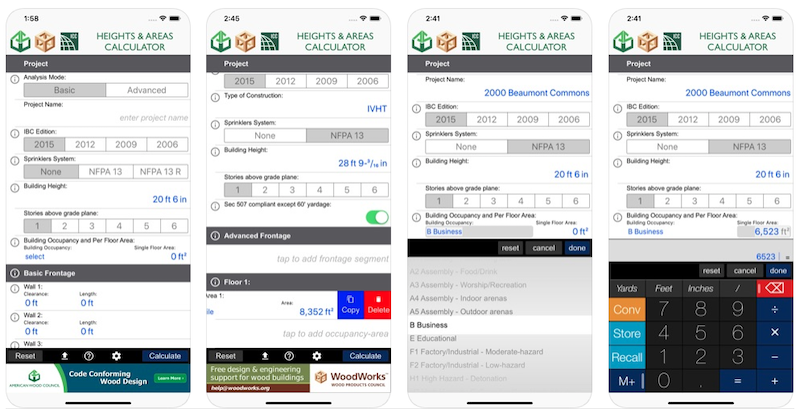A free app that calculates the maximum allowable heights and areas for buildings of various occupancy classifications and types of construction has been released.
The Heights & Areas Calculator, developed by the International Code Council, the American Wood Council, and WoodWorks, is based on provisions in the 2006 to 2015 editions of the International Building Code.
Users can input a given building geometry, site conditions (e.g., open frontage), type of construction, and occupancy.
The tool then shows allowable types of construction that are permitted. The “basic” version of the calculator limits building input to a single occupancy and equal floor areas for the entire building. An “advanced” option permits multiple occupancies and different floor areas.
“We often work with design teams that are exploring wood construction as a way to cost-effectively increase the density of their projects,” said Bill Parsons, vice president of operations for WoodWorks, in a news release. “The new heights and areas app lets building designers quickly determine if they’re maximizing value based on the objectives of the project, and to compare the options available with different construction types.”
Related Stories
Codes and Standards | Apr 20, 2017
California lawmakers have had little success in attracting sports stadiums
Only one of several attempts has had an impact in recent years.
Codes and Standards | Apr 19, 2017
Dept. of Energy releases updated versions of EnergyPlus and OpenStudio building energy modeling tools
The updated versions include full support for variable speed DX coils, enhanced plant auto-sizing, new fan model, and support for non-rectangular windows.
Codes and Standards | Apr 18, 2017
K-12 school daylighting initiative created to promote best practices
Eneref Institute creates networking group of school administrators for ideas to overcome market obstacles.
Codes and Standards | Apr 17, 2017
OSHA delays enforcing crystalline silica standard in construction industry
Enforcement will begin Sept. 23, three months later than planned.
Codes and Standards | Apr 13, 2017
Former OSHA official publishes safety citations on his own
Under Trump orders, agency had stopped issuing ‘shaming’ press releases on major fines and safety violations.
Codes and Standards | Apr 12, 2017
Trump infrastructure task force suggests arbitration to speed projects
Permitting process could be reduced from 10 years to 2 years under the proposal.
Codes and Standards | Apr 11, 2017
2017 National Energy Codes Conference includes code boot camp, PNC Tower tour
The DOE-sponsored event will be held in Pittsburgh July 17-20.
Codes and Standards | Apr 10, 2017
Congressional hearing on skills gap includes look at construction industry
Strategies to boost ranks of construction workers include mentoring programs, increased safety measures, trade group support, and outreach to school counselors.
Codes and Standards | Apr 6, 2017
Product-specific EPDs seen as key aid to earning green building credits
The product-specific EPDs allow designers to more quickly earn a LEED v4 credit in the Materials & Resources category.
Codes and Standards | Apr 5, 2017
Updated AIA Disaster Assistance Handbook released with significant enhancements
Updates provide guidance on how design and construction pros and emergency managers can work together to prepare for and respond to disasters.

















